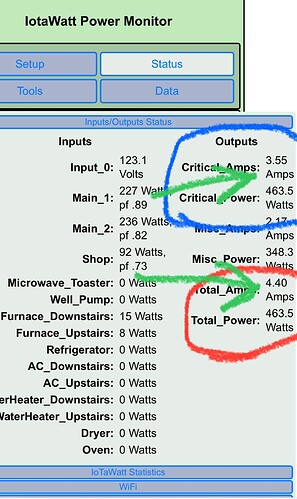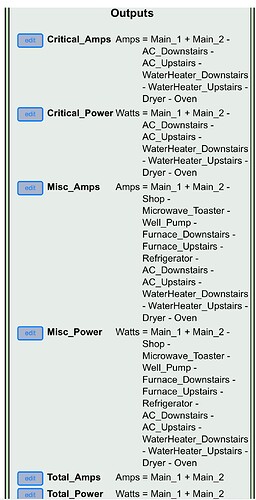I’ve searched this forum but haven’t come across the answer. I have created an output for critical circuits that I want to monitor for use with a generator. Part of the output is basically the miscellaneous electricity not directly measured which is the amount left over from subtracting the measured circuits from the mains. What I can’t figure out is why the amps at the mains consistently measure ~.8 - .9 amps more than the critical output my script is calculating. I am posting an example where the main watts and critical watts happen to be the same and at the same time the amps don’t agree. Appreciate any help or advice I can get. Thank you.
That is a complicated topic. It has to do with reactive power. When a load has a power factor less than unity (1.00), it doesn’t use all of the current to do work. Some of it is “returned” to the source as reactive power. Because Amps are measured as RMS, the total includes both the current that did work (real power) and the current that was returned (reactive power), When you have a number of loads connected to the same source, as in your panel, one load may use some or all of the reactive power produced by another. It’s kind of like recycling. The end result is that the total of the Amps measured at the branch circuits will be typically more than the Amps that pass through the mains.
It is generally better to reconcile the mains and loads using Watts as they are only based on the real power and do not consider the reactive power.
Thank you for the explanation. I think the sum of my individual circuits is actually less than the mains, but I get your point. I believe my amp difference is coming from my misc circuits. There are 28 breakers supplying that small amount that are lightly loaded, which no doubt throws the measurement off. I will use watts which looks to be spot on. I really like the IoTaWatt system.
As overeasy said, you probably have reactive power floating around. It sounds like your goal is to not overload your generator? There are two different ways to overload your generator. The obvious one is load it up with too many watts. I guess your critical power measurement will keep you from do that, assuming you have captured all your loads, although it’s not entirely clear to me. But you can also overload your generator with a reactive load. Now normally, this is extremely unlikely. But the point is that the generator itself, (as distinct from the engine), only cares about amps, not watts. It’s the number of amps flowing through the generator windings that matter. It’s the amps that are heating up the windings. A highly reactive load can overload the generator end without overloading the engine.
But related to this is another possible issue. If you have, say, a 5kw, 240vac generator, what you really have is two 2.5kw, 120vac generators in series. It’s quite easy to overload one side without overloading the generator overall. You cannot pull 4kw from one side and nothing from the other, you will trip the breaker on the generator. (hopefully)
My personal preference is to monitor the actual output of the generator, then one can read the watts and amps directly, and see how the load is distributed between the legs.
Thank you for this insight regarding the generator. Yes I want to size a generator to match my critical loads but not so large that I’m just burning a bunch of fuel and not maximizing my power. My generator will interlock (and lock out the grid) at my main power feed and I’m hoping I can track the load at the mains (as supplied by the generator) to not overload it. I’m new at this, the discussion about reactive power is new to me.
I think your worst starting load is the thing that ends up sizing your generator. At least it is for me, and the worst is my furnace. My average load is about 600 watts. My furnace adds about 400, kicking it up to 1000. I have a 2.2kw honda, so it runs it fine, but it was iffy for starting. I ended up adding a soft starter to my furnace. On the other hand, I have a lot of inverter driven stuff. My refrigerator, an air conditioner, and my main 220v heat pump. All of these have no starting load at all. And they also don’t ever seem to run at full power. So I can get away with running all of this stuff as long as I’m reasonably careful.
If you have any big motors, you have to leave a reserve in your load in case that item starts up. So while in theory I could use a 1kw gen set, in reality I need a 2.2wk gen set.
I have 2 furnaces in my house and one in my shop to juggle. Plus all the small things (ie coffee maker, microwave etc) to have some quality of life through an outage. The IoTaWatt will be great to sort this out. I appreciate your comments as well as others on here and it gives me other things to consider I would not have thought about. I admire that you can use such a small generator to keep the essentials going!

